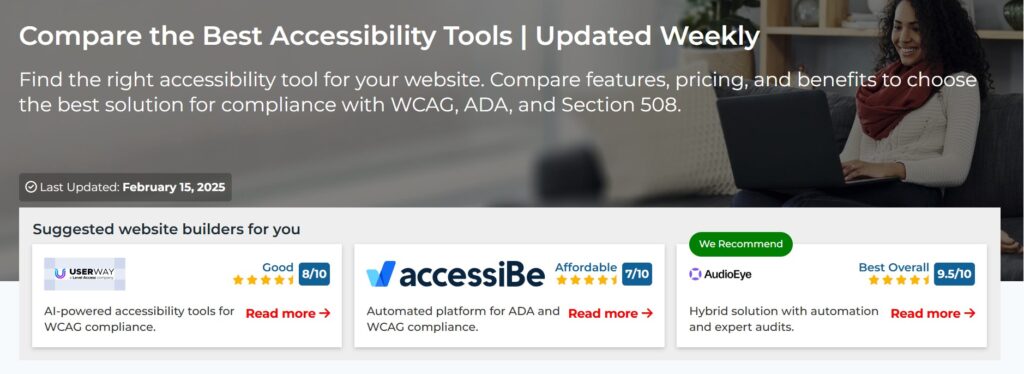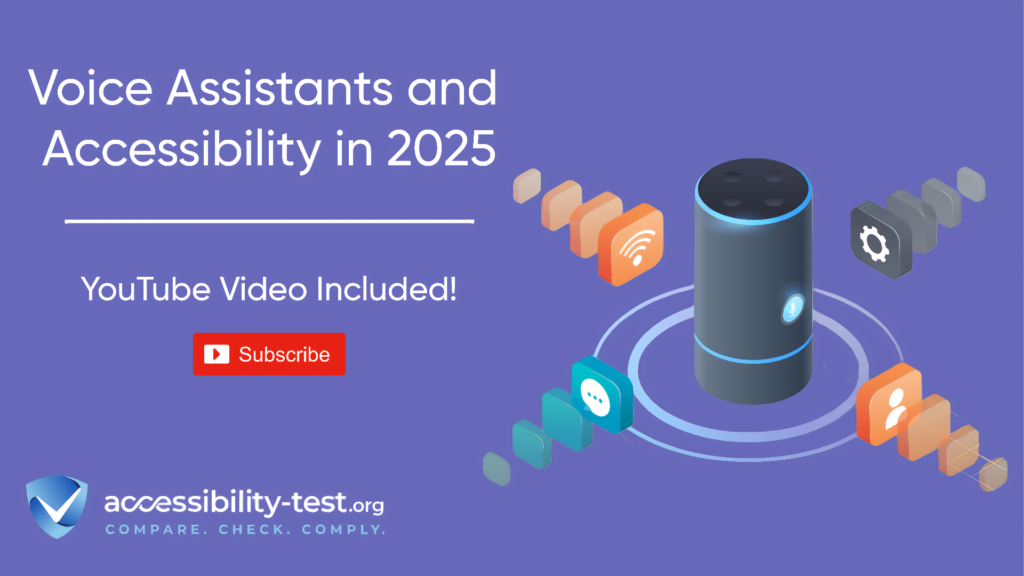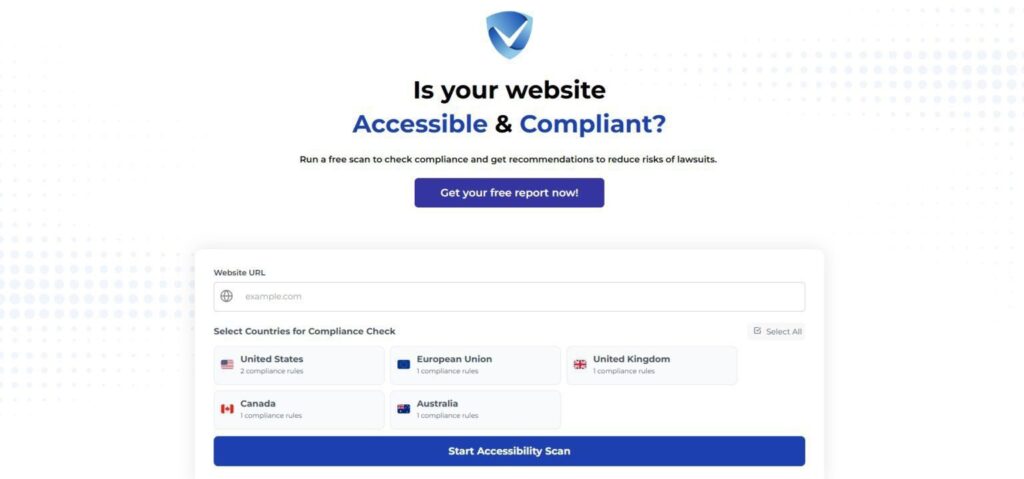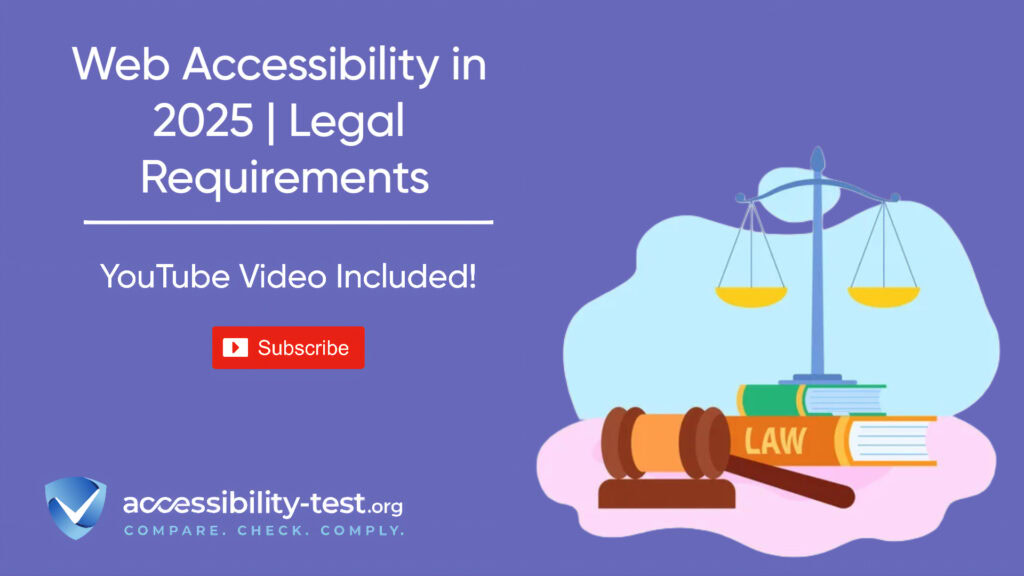What Is Web Accessibility?
Web accessibility refers to the practice of designing and developing websites that are usable by people of all abilities and disabilities. It is a critical aspect of creating inclusive digital environments, ensuring that individuals with disabilities can access information and functionality on the web just as easily as those without disabilities. As we move towards 2025, the importance of web accessibility continues to grow, driven by legal requirements and social responsibility.
One of the core purposes of web accessibility is to remove barriers that might prevent individuals with disabilities from navigating and interacting with websites effectively. This includes a wide range of disabilities, such as visual impairments, hearing loss, cognitive impairments, and motor disabilities. By adhering to web accessibility guidelines, such as the Web Content Accessibility Guidelines (WCAG), developers and designers can create websites that are perceivable, operable, understandable, and robust.
Moreover, an increasing global emphasis on digital accessibility is fostering a more inclusive internet. Many countries are implementing or have already established legal frameworks that require adherence to accessibility standards. These regulations aim to ensure that people with disabilities receive equitable access to digital information, products, and services. This growing legal mandate not only highlights the importance of web accessibility but also serves as encouragement for organizations to prioritize it in their digital strategies.
In today’s society, where many aspects of life are conducted online, the need for web accessibility has never been more evident. An accessible website not only complies with legal requirements but also provides a better user experience for all. As we approach 2025, understanding and integrating web accessibility into digital practices will be key to fostering inclusivity and promoting equal access to information for everyone.

Current Web Accessibility Standards
Web accessibility is an essential aspect of digital content creation, ensuring that all users, including those with disabilities, can access and interact with online information. The cornerstone of web accessibility standards is the Web Content Accessibility Guidelines (WCAG) 2.1, which were developed by the World Wide Web Consortium (W3C). These guidelines aim to provide a comprehensive framework for making the web more accessible to a wider range of users. WCAG is structured around four key principles: Perceivable, Operable, Understandable, and Robust (POUR).
WCAG 2.1 introduces three levels of conformance—A, AA, and AAA—each delineating different requirements. The lowest level, Level A, includes the most basic web accessibility features that must be implemented. Examples include providing text alternatives for non-text content, ensuring that all interactive elements are navigable through keyboard controls, and not using low-contrast colors that hinder visibility. Level A compliance is a fundamental starting point for web developers and organizations committed to enhancing accessibility.
Level AA builds upon Level A by addressing issues that are more common barriers for users with disabilities. This level includes additional requirements, such as ensuring that text has sufficient contrast against its background, providing captions for live audio content, and making all functionality available from a keyboard. Meeting Level AA standards is generally considered a benchmark for most organizations aiming to comply with web accessibility laws.
Level AAA represents the highest level of web accessibility, aiming to ensure the optimum experience for all users, including those with more severe disabilities. This level includes extensive criteria such as sign language interpretation for all audio content and enhanced navigation techniques. While achieving AAA conformance is encouraged, it is often viewed as impractical for many organizations.
Adhering to these standards is crucial as they form the legal basis for web accessibility in many jurisdictions, consequently affecting web developers and organizations that wish to maintain compliance while fostering an inclusive online environment.
Anticipated Changes in Legal Requirements by 2025
As we approach 2025, the realm of web accessibility is poised for significant transformation, primarily driven by emerging legal requirements. In recent years, global awareness regarding the importance of inclusivity for individuals with disabilities has surged, prompting nations to reevaluate their legal frameworks surrounding web accessibility. This trend indicates a decisive shift toward stricter compliance measures for organizations across various sectors.
One notable development is the potential expansion of existing regulations such as the Americans with Disabilities Act (ADA) in the United States. Many advocates predict a more defined set of standards for digital accessibility, possibly aligning with the Web Content Accessibility Guidelines (WCAG) 2.1 or 2.2 as a benchmark for compliance. Similarly, European countries are expected to adopt more stringent laws in line with the European Accessibility Act, which mandates that public sector websites and applications must be accessible, pushing non-compliant private sector entities to follow suit.
Furthermore, emerging markets and developing nations are beginning to introduce accessibility legislation, reflecting a global trend of prioritizing digital equality. For instance, countries in Asia and Africa are increasingly recognizing the need for inclusive digital environments, leading to the introduction of new laws that establish standards for web accessibility. Organizations operating internationally must therefore remain vigilant, as compliance requirements may differ significantly across jurisdictions.
Additionally, the rise of litigation concerning web accessibility highlights the urgency for businesses to adapt their strategies to avoid potential legal repercussions. Companies may need to invest in comprehensive accessibility audits and employee training programs to ensure adherence to the evolving legal landscape. By understanding the anticipated changes in legal requirements, organizations can proactively enhance their compliance strategies while fostering a more inclusive digital experience for all users.

Impact of Global Movements and Initiatives
In recent years, the momentum towards enhancing web accessibility has been significantly shaped by various global movements and initiatives. Among the most notable is the United Nations’ Sustainable Development Goals (SDGs), which encompass a commitment to ensure inclusivity and equal access to information and technology. Specifically, Goal 4 emphasizes the importance of inclusive education, while Goal 10 advocates for reduced inequalities. These objectives align with the push for greater web accessibility, fostering an environment where people with disabilities can equally engage with digital platforms.
Furthermore, disability rights movements worldwide have been instrumental in advocating for the rights of individuals with disabilities, pushing for legislative changes that require organizations and governments to prioritize accessibility in their web offerings. These movements have raised awareness of the challenges faced by individuals with various impairments and have spurred action at both national and international levels. As a result, many governments have begun reevaluating and updating their legal frameworks surrounding web accessibility, often aligning them with the Web Content Accessibility Guidelines (WCAG) to ensure compliance and inclusivity.
In addition to governmental efforts, private sector initiatives have emerged as key players in this landscape. Organizations are increasingly recognizing that accessibility is not merely a legal obligation but also a vital aspect of corporate social responsibility. Consequently, many companies are adopting inclusive design practices, leveraging various technologies and strategies to enhance accessibility on their websites. This shift demonstrates a growing acknowledgment that accessibility contributes not only to legal compliance but also to improved user experience and engagement.
Overall, the interplay between global movements advocating for web accessibility and evolving legal requirements signifies a crucial shift towards promoting an inclusive digital environment. As we approach 2025, it is evident that these initiatives are paving the way for more rigorous accessibility standards in legislation, leading to a more equitable web presence for all users.
Penalties for Non-Compliance
As the emphasis on web accessibility continues to grow, organizations that fail to meet the legal requirements may face significant repercussions in 2025 and beyond. The legal landscape surrounding web accessibility is primarily guided by the Americans with Disabilities Act (ADA) and Section 508 of the Rehabilitation Act in the United States. Non-compliance with these laws can result in a variety of penalties, which may include lawsuits, financial penalties, and mandated changes to websites and applications.
In recent years, several high-profile lawsuits have underscored the legal risks associated with web accessibility failures. For instance, organizations have been sued for not providing adequate access to their websites for individuals with disabilities. These cases often involve claims related to inaccessible navigation, lack of alternative text for images, and inadequate video captioning. The settlements in such cases frequently amount to substantial sums, sometimes reaching into the millions. This creates not only financial implications for the organization but also reputational damage that can lead to a loss of customer trust.
In addition to litigation, organizations may also incur fines from regulatory bodies. These fines are particularly common in sectors where accessibility compliance is critical, such as government, education, and healthcare. Depending on the jurisdiction, penalties can vary widely, from warnings and mandates for corrective action to potential fines based on the scope of the violation and the size of the organization. The commitment to maintaining web accessibility standards is not just a legal obligation but a social responsibility that can significantly affect an organization’s standing in the marketplace.
To mitigate the risk of non-compliance, organizations are encouraged to proactively assess their web accessibility through audits and user testing with individuals who have disabilities. Implementing necessary changes not only helps avoid penalties but also contributes to a more inclusive online environment for all users implementation and ongoing maintenance, fostering an inclusive online environment.

Best Practices for Compliance
As organizations strive to ensure web accessibility in 2025, adhering to established standards is critical for both legal compliance and fostering an inclusive digital environment. Implementing best practices can significantly improve accessibility for users with disabilities. One fundamental strategy is to familiarize oneself with the Web Content Accessibility Guidelines (WCAG), which provide a comprehensive framework for creating accessible web content.
Web developers and content creators should prioritize semantic HTML as a foundational practice. Using proper headings, lists, and form elements not only enhances accessibility but also improves search engine optimization (SEO). This approach ensures that assistive technologies like screen readers can navigate the structure of the web page efficiently. Additionally, adhering to ARIA (Accessible Rich Internet Applications) roles and properties can further enhance the meaning of UI elements, making it easier for users with disabilities to understand and interact with content.
Incorporating keyboard navigation is essential. Many users rely on keyboards or alternative input devices to navigate websites. Ensuring that all interactive elements, such as forms, menus, and buttons, can be accessed using a keyboard alone prevents exclusion of individuals with mobility impairments. Furthermore, organizations should conduct regular accessibility audits using automated tools and manual testing. Popular tools like Wave and Axe can help identify common barriers, while user testing with people with disabilities provides invaluable insights into real-world experiences.
Educating web teams on inclusive design practices is also vital. Developing a culture that values accessibility from the start can lead to more innovative and user-friendly projects. Training sessions, workshops, and comprehensive resources can empower staff members to incorporate accessibility principles into their workflows. By placing emphasis on these best practices, organizations can effectively align with web accessibility standards and create a more inclusive digital landscape for all users.
The Role of Technology in Enhancing Accessibility

As we progress into 2025, the role of technology in improving web accessibility is becoming increasingly significant. Emerging technologies, particularly artificial intelligence (AI) and machine learning, are transforming how organizations approach the legal requirements for accessible web design. These technologies offer innovative tools that not only streamline compliance processes but also enhance the overall user experience for individuals with disabilities.
AI-powered solutions are particularly beneficial in identifying and rectifying accessibility issues on websites. Smart algorithms can analyze web pages in real-time, identifying elements that may hinder users’ ability to navigate content efficiently. For example, AI can evaluate color contrast ratios, ensure the presence of alternative text for images, and assess navigation structure, providing immediate feedback to developers and content creators.
Moreover, machine learning models can learn from user interactions, optimizing the accessibility features based on real-world use cases. This continual improvement allows organizations to evolve their digital offerings in line with user needs while adhering to legal requirements. For instance, AI-driven tools can suggest modifications to user interfaces to enhance readability or improve screen reader compatibility, thus fostering inclusivity.
In addition, emerging technologies also contribute to the creation of adaptive web environments. By implementing responsive design principles powered by AI, organizations can create websites that are not only technologically advanced but also user-centric. These websites can automatically adjust layouts and content presentation based on users’ preferences or assistive technology being utilized, providing a tailored experience that adheres to accessibility standards.
In conclusion, the integration of AI and machine learning into web development promises significant advancements in compliance with accessibility laws. By utilizing these technologies, organizations can enhance their digital presence, ensuring that they meet the evolving legal requirements while providing a more inclusive experience for all users.
Case Studies of Successful Accessibility Implementation
In recent years, numerous organizations have made significant strides in implementing web accessibility features, setting examples for others in various sectors. One prominent case is that of the multinational corporation, Microsoft. The company undertook a comprehensive accessibility initiative by integrating inclusive design principles from the early stages of product development. They adopted accessibility tools, such as screen readers and keyboard navigation, ensuring that all users, including those with disabilities, could effectively engage with their services. This commitment not only expanded their user base but also improved overall user experience, resulting in high satisfaction ratings.
Another noteworthy example can be found in the nonprofit sector with the American Red Cross. The organization recognized that its website needed to better serve individuals with disabilities, particularly during emergencies. By conducting extensive user testing with people who have disabilities, they identified specific barriers within their online platforms. Subsequently, they implemented various accessibility solutions, such as alt text for images and simplified navigation. As a result, the improvement in accessibility forged stronger connections with the community and enabled more people to access vital disaster preparedness information easily.
Moreover, the global fashion retailer, ASOS, prioritized accessibility by staying abreast of evolving accessibility standards. They launched a strategic plan to incorporate accessibility features throughout their e-commerce platform. Challenges such as legacy systems and design changes were met with collaborative efforts involving cross-functional teams. Through consistent training and investments in accessible technology, ASOS reported an increase in conversion rates and a more diverse customer base, underscoring the business benefits of prioritizing web accessibility.
These case studies exemplify that when organizations prioritize web accessibility, they not only adhere to legal requirements but also enrich the user experience and broaden their audience reach. The strategies adopted in these examples highlight the transformative impact of integrating accessibility into core business practices.

As we consider the trajectory of web accessibility leading into 2025, it is imperative to recognize the vital role that legal requirements play in shaping digital landscapes. Throughout this blog post, we have explored various components of web accessibility, including compliance standards, the legal implications of neglecting inclusivity, and the social responsibility of organizations to enhance user experiences for all individuals, regardless of their abilities. The imminent updates to regulations are expected to enforce stricter adherence to accessibility standards, compelling businesses to prioritize inclusivity in their web designs.
The significance of web accessibility extends beyond mere compliance; it encompasses ethical considerations and the commitment to fostering an inclusive society. Organizations that fail to align with emerging legal requirements risk facing legal repercussions while simultaneously alienating a significant portion of the population that relies on accessible digital interfaces. By proactively embracing these requirements, businesses can create a more welcoming online environment that encourages interaction and engagement with their services.
Looking ahead, the future of web accessibility is likely to be characterized by technological advancements and a more profound societal commitment to inclusivity. Innovations such as artificial intelligence and machine learning are poised to facilitate more robust accessibility features, enabling enhanced navigation, content consumption, and interaction for users with diverse needs. As organizations adapt to these changes, the emphasis on user-centered design will grow, marking a significant shift towards prioritizing accessibility rather than treating it as an afterthought.
Ultimately, it is essential for stakeholders to remain informed and responsive to evolving legal requirements and technological advancements related to web accessibility. By fostering a culture of inclusivity, businesses can not only fulfill legal obligations but also cultivate broader community engagement and enhance overall user satisfaction in a digital world that strives to be accessible for all.



